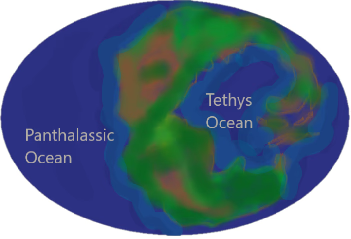From Fossils to Fuel
When Earth's tectonic plates moved, pieces of continental land drifted in to an ancient ocean.
The ocean dried up. Rocks piled up on fossils of sea organisms.

with the Tethys sea before continental drift
250 million years ago dinosaurs roamed Earth. It was the start of a period called " Mesozoic era ". There were only two
continents on Earth. One in the North, called Laurasia and other in the south, called Gondwana. An ancient ocean stretched between them, called
the Tethys ocean. It spread out on both sides of the equator. Tropical climate made tiny planktons and algae grow well in its warm waters.
Meanwhile, big changes were taking place below. Earth's rocky plates were moving. Laurasia and Gondwana broke. Chunks of land drifted in to the Tethys ocean. Some went far, others drifted close by. Broken chunks
joined together making new continents. When two pieces of land clashed, Earths plates slided between each other, rising and falling to form mountains.
Alpine and Himalayan mountain ranges were formed by chunks from Laurasia and Gondwana coming together. Even today, hikers climbing up Himalayan peaks come across fossils of
prehistoric marine creatures, dating back to the Tethys ocean.
New continents
Laurasia broke in to North America, most of Europe (north of the Alps) and Asia (North of the Himalayas). Gondwana formed South America, Africa, parts of Europe (below Alps), parts of Asia (below Himalayas), Australia, and Antartica.
Continental Drift
As Laurasia and Gondwana broke, Tethys ocean was caught between moving pieces of land. Much of it ran underground. Dead planktons and algae collected on the sea floor. As the ocean dried, layers of soil were deposited on the dead planktons. Years went by... high temperature and pressure crushed them in to a greasy, oily mass. Nothing remains of the fossils today, except for slimy oil. This oil oozes up between rocks. Modern oil wells pump up this oil and process it to make gasoline (petrol).
How fossil fuel is formed
Oil wells in gulf countries trace their origin to microscopic planktons and algae of the Tethys sea buried under desert sands 200 million years ago. 60% of the gasoline or petrol we use today is from remains of these tiny creatures of the Mesozoic era.
